Related Research Articles
Witchcraft is the use of alleged supernatural powers of magic. A witch is a practitioner of witchcraft. Traditionally, "witchcraft" means the use of magic or supernatural powers to inflict harm or misfortune on others, and this remains the most common and widespread meaning. According to Encyclopedia Britannica, "Witchcraft thus defined exists more in the imagination of contemporaries than in any objective reality", but it "has constituted for many cultures a viable explanation of evil in the world". The belief in witchcraft has been found throughout history in a great number of societies worldwide. Anthropologists have applied the English term "witchcraft" to similar beliefs in occult practices in many different cultures, and societies that have adopted the English language have often internalised the term.
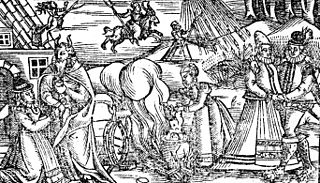
Isobel Gowdie was a Scottish woman who confessed to witchcraft at Auldearn near Nairn during 1662. Scant information is available about her age or life and, although she was probably executed in line with the usual practice, it is uncertain whether this was the case or if she was allowed to return to the obscurity of her former life as a cottar’s wife. Her detailed testimony, apparently achieved without the use of violent torture, provides one of the most comprehensive insights into European witchcraft folklore at the end of the era of witch-hunts.
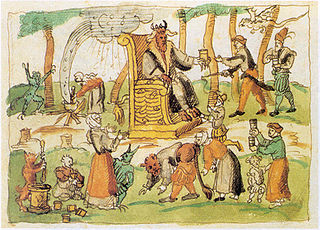
A Witches' Sabbath is a purported gathering of those believed to practice witchcraft and other rituals. The phrase became especially popular in the 20th century.

In European folklore of the medieval and early modern periods, familiars were believed to be supernatural entities, interdimensional beings, or spiritual guardians that would protect or assist witches and cunning folk in their practice of magic, divination, and spiritual insight. According to records of the time, those alleging to have had contact with familiar spirits reported that they could manifest as numerous forms, usually as an animal, but sometimes as a human or humanoid figure, and were described as "clearly defined, three-dimensional... forms, vivid with colour and animated with movement and sound", as opposed to descriptions of ghosts with their "smoky, undefined form[s]".
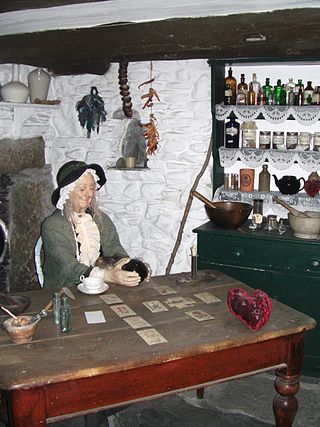
The cunning folk were professional or semi-professional practitioners of magic in Europe from the medieval period through the early 20th century. In Britain they were known by a variety of names in different regions of the country, including wise men and wise women, pellars, wizards, dyn hysbys, and sometimes white witches.

Carlo Ginzburg is an Italian historian and a proponent of the field of microhistory. He is best known for Il formaggio e i vermi, which examined the beliefs of an Italian heretic, Menocchio, from Montereale Valcellina.
The benandanti were members of an agrarian visionary tradition in the Friuli district of Northeastern Italy during the 16th and 17th centuries. The benandanti claimed to travel out of their bodies while asleep to struggle against malevolent witches in order to ensure good crops for the season to come. Between 1575 and 1675, in the midst of the Early Modern witch trials, a number of benandanti were accused of being heretics or witches under the Roman Inquisition.
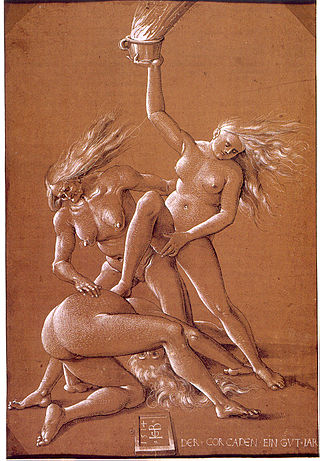
European belief in witchcraft can be traced back to classical antiquity, when magic and religion were closely entwined. During the pagan era of ancient Rome, there were laws against harmful magic. After Christianization, the medieval Catholic Church began to see witchcraft (maleficium) as a blend of black magic and apostasy involving a pact with the Devil. During the early modern period, witch hunts became widespread in Europe, partly fueled by religious tensions, societal anxieties, and economic upheaval. European belief in witchcraft gradually dwindled during and after the Age of Enlightenment.

Witch, from the Old English wiċċe, is a term rooted in European folklore and superstition for a practitioner of witchcraft, magic or sorcery. Traditionally associated with malevolent magic, with those accused of witchcraft being the target of witch-hunts, in the modern era the term has taken on different meanings. In literature, a 'witch' can now simply refer to an alluring women capable of 'bewitching' others. In neopagan religions such as Wicca the term has meanwhile been adopted as the female term for an adherent.
Evidence of magic use and witch trials were prevalent in the Early Modern period, and Inquisitorial prosecution of witches and magic users in Italy during this period was widely documented. Primary sources unearthed from Vatican and city archives offer insights into this phenomenon, and notable Early Modern microhistorians such as Guido Ruggiero, Maria Sofia Messana, Angelo Buttice and Carlo Ginzburg, have defined their careers detailing this topic. In addition, Giovanni Romeo's monograph Inquisitori, esorcisti e streghe nell'Italia della Controriforma (1990) was considered pioneering and marked an important step forward in inquisitorial and witchcraft studies dealing with early modern Italy.In last 25 years a jurist and researcher on trials against witches, add many informations: the names of people involved in witchcraft, their jobs, the meetings. Monia Montechiarini in 'Stregoneria: Crimine Femminile', 'Streghe, eretici e benandanti del Friuli Venezia Giulia' and 'Streghe, Avvelenatrici e Cortigiane di Roma' discovered new secrets.

The witch-cult hypothesis is a discredited theory that the witch trials of the Early Modern period were an attempt to suppress a pagan religion that had survived the Christianization of Europe. According to its proponents, accused witches were actually followers of this alleged religion. They argue that the supposed 'witch cult' revolved around worshiping a Horned God of fertility and the underworld, whom Christian persecutors identified with the Devil, and whose followers held nocturnal rites at the witches' Sabbath.
The Witch-Cult in Western Europe is a 1921 anthropological book by Margaret Murray, published at the height of the success of Frazer's Golden Bough. Certain university circles subsequently celebrated Margaret Murray as the expert on western witchcraft, though her theories were widely discredited. Over the period 1929-1968, she wrote the "Witchcraft" article in successive editions of the Encyclopædia Britannica.

Emma Wilby is a British historian and author specialising in the magical beliefs of Early Modern Britain.
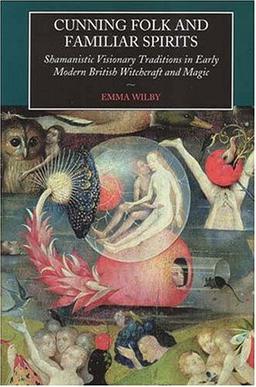
Cunning Folk and Familiar Spirits: Shamanistic Visionary Traditions in Early Modern British Witchcraft and Magic is a study of the beliefs regarding witchcraft and magic in Early Modern Britain written by the British historian Emma Wilby. First published by Sussex Academic Press in 2003, the book presented Wilby's theory that the beliefs regarding familiar spirits found among magical practitioners – both benevolent cunning folk and malevolent witches – reflected evidence for a general folk belief in these beings, which stemmed from a pre-Christian visionary tradition.

Between the Living and the Dead: A Perspective on Witches and Seers in the Early Modern Age is a study of the beliefs regarding witchcraft and magic in Early Modern Hungary written by the Hungarian historian Éva Pócs. The study was first published in Hungarian in 1997 as Élők és holtak, látók és boszorkányok by Akadémiai Kiadó. In 1999, it was later translated into English by Szilvia Rédey and Michael Webb and published by the Central European University Press.
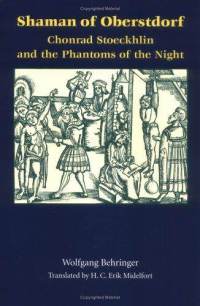
Shaman of Oberstdorf: Chonrad Stoeckhlin and the Phantoms of the Night is a study of the arrest and trial of Chonrad Stoecklin (1549–1587), a German herdsman from the town of Oberstdorf who was accused and executed for the crime of witchcraft after experiencing a series of visions. Written by the German historian Wolfgang Behringer, himself a specialist in the Early Modern witch trials of Germany, Shaman of Oberstdorf was initially published in German as Chonrad Stoekhlin und die Nachtschar: Eine Geschichte aus der frühen Neuzeit by R. Piper GmbH & Co. in 1994. It was subsequently translated into English by H.C. Erik Midelfort and published in 1998 by the University of Virginia Press.
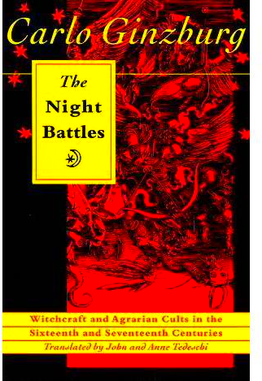
The Night Battles: Witchcraft and Agrarian Cults in the Sixteenth and Seventeenth Centuries is a historical study of the benandanti folk custom of 16th and 17th century Friuli, Northeastern Italy. It was written by the Italian historian Carlo Ginzburg, then of the University of Bologna, and first published by the company Giulio Einaudi in 1966 under the Italian title of I Benandanti: Stregoneria e culti agrari tra Cinquecento e Seicento. It was later translated into English by John and Anne Tedeschi and published by Routledge and Kegan Paul in 1983 with a new foreword written by the historian Eric Hobsbawm.

Ecstasies: Deciphering the Witches' Sabbath is a study of visionary traditions in Early Modern Europe written by the Italian historian Carlo Ginzburg. First published by Giulio Einaudi in 1989 under the Italian title Storia notturna: Una decifrazione del Sabba, it was later translated into English by Raymond Rosenthal and published by Hutchinson Radius in 1990.
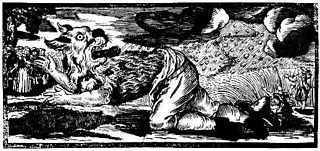
Thiess of Kaltenbrun, also spelled Thies, and commonly referred to as the Livonian werewolf, was a Livonian man who was put on trial for heresy in Jürgensburg, Swedish Livonia, in 1692. At the time in his eighties, Thiess openly proclaimed himself to be a werewolf (wahrwolff), claiming that he ventured into Hell with other werewolves in order to do battle with the Devil and his witches. Although claiming that as a werewolf he was a "hound of God", the judges deemed him guilty of trying to turn people away from Christianity, and he was sentenced to be both flogged and banished for life.

The Bute witches were six Scottish women accused of witchcraft and interrogated in the parish of Rothesay on Bute during the Great Scottish Witch Hunt of 1661–62. The Privy Council granted a Commission of Justiciary for a local trial to be held and four of the women – believed by historians to be Margaret McLevin, Margaret McWilliam, Janet Morrison and Isobell McNicoll – were executed in 1662; a fifth may have died while incarcerated. One woman, Jonet NcNicoll, escaped from prison before she could be executed but when she returned to the island in 1673 the sentence was implemented.
References
- ↑ Ginzburg, Carlo (1983). The Night Battles: Witchcraft and Agrarian Cults in the Sixteenth and Seventeenth Centuries. Baltimore: The Johns Hopkins University Press.
- ↑ Ginzburg, Carlo (1991). Ecstasies: Deciphering the Witches' Sabbath. London: Penguin.
- ↑ Pocs, Eva (1999). Between the Living and the Dead. Budapest: Central European University Press.
- ↑ Wilby, Emma (2005). Cunning Folk and Familiar Spirits: Shamanistic Visionary Traditions in Early Modern British Witchcraft and Magic. Brighton: Sussex Academic Press.
- ↑ Wilby, Emma (2010). The Visions of Isabel Gowdie: Magic, Witchcraft and Dark Shamanism in Seventeenth-Century Scotland. Brighton: Sussex Academic Press.
- ↑ Eric R. Dodds (1951). The Greeks and the Irrational, Berkeley, University of California Press, 1951.
- ↑ Michael J. Puett (2002). To Become a God: Cosmology, Sacrifice, and Self-divinization in Early China, Cambridge, Harvard University Press, pp. 83-86.